Synology 2023/2024 Q&A with Taiwan Headquarters – Your Questions Answered
Synology have always been largely considered to be the market leader in the world of network attached storage (NAS) and more often than not the decisions that make in their range of hardware/software solutions tend to be of tremendous interest to their growing global user base. Whether it’s a feature of DSM that has been added/removed, or a hardware path that they have yet to pursue, may users have questions for this big brand is the world of big data! So, today we want to share our latest Q&A with Synology (something of an annual event in itself now, with 2019 here, 2020 here, etc), in which we spoke with Michael Wang, Corporate Communications Manager at Synology, and put forward your user questions from the YouTube comments, Polls and NASCompares forums/discord/social media channels. So, let’s dive straight in and see what the brand have in store for the 2nd half of 2023 as we shift our attention towards Synology 2024.
It’s Been a While Since we saw a Synology Play Series class device. Has the Play series of devices now been retired?
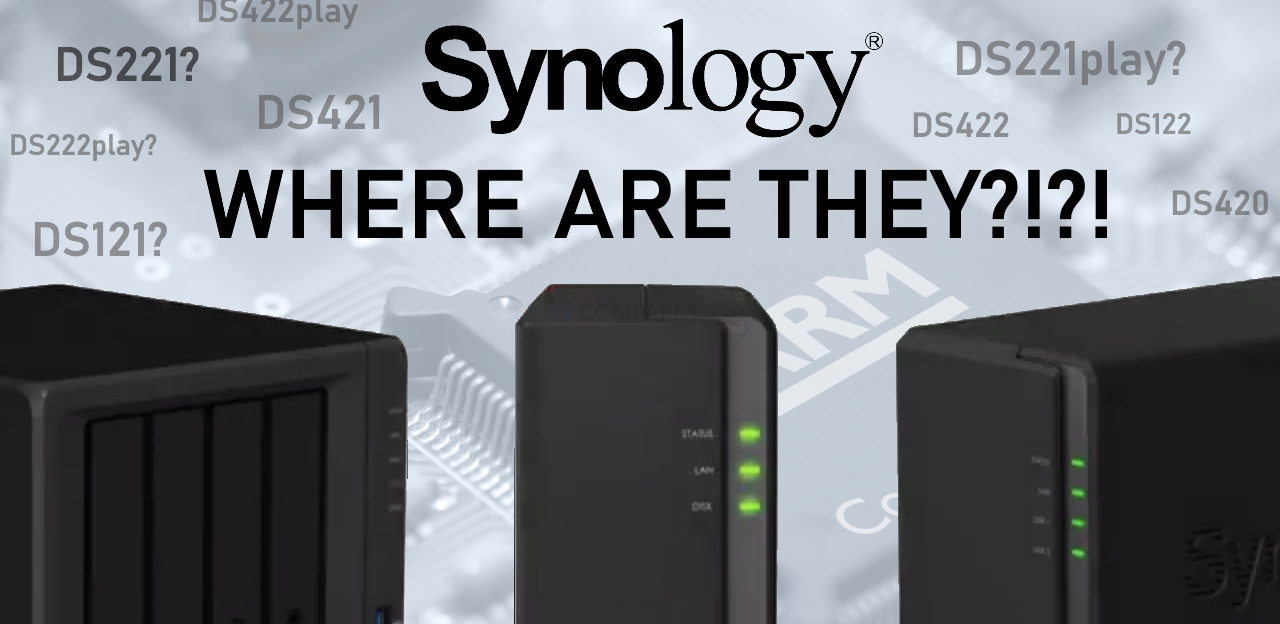
There are no plans for new Play Series systems at the moment. Our tower lineup already offers numerous options within the lower price band. When we released it, the Play Series was focused on multimedia organization and sharing. Today, any Synology system can easily satisfy such needs. Therefore a new entry into our portfolio that is presented as a multimedia-focused solution has become increasingly unnecessary, as solutions such as our Synology DS223 and DS423 are able to provide an excellent balance between value, efficiency and ability, for both multimedia and non-multimedia users. Further entries in our tower series only further improve upon this balance.
Will a Synology Network Switch ever be a thing? It seems to be the last piece in the ecosystem puzzle.
Synology is always evaluating the needs of the market. If there’s a significant market opportunity that presents itself for a product that can make use of our existing strengths or would tie in well with the rest of our solutions, it can be a possibility. We do not want to introduce a network switch into our portfolio until we know we can bring something new and unique that cannot be achieved already elsewhere. Take, for example, our growing router range, powered by SRM 1.3. We believe that it brings features and services that are unavailable elsewhere in the router market, to the same standard, user experience or value, such as Synology Safe Search and VPN Plus Server. We are often asked about the subject of producing our own switch, so never say ‘never’.
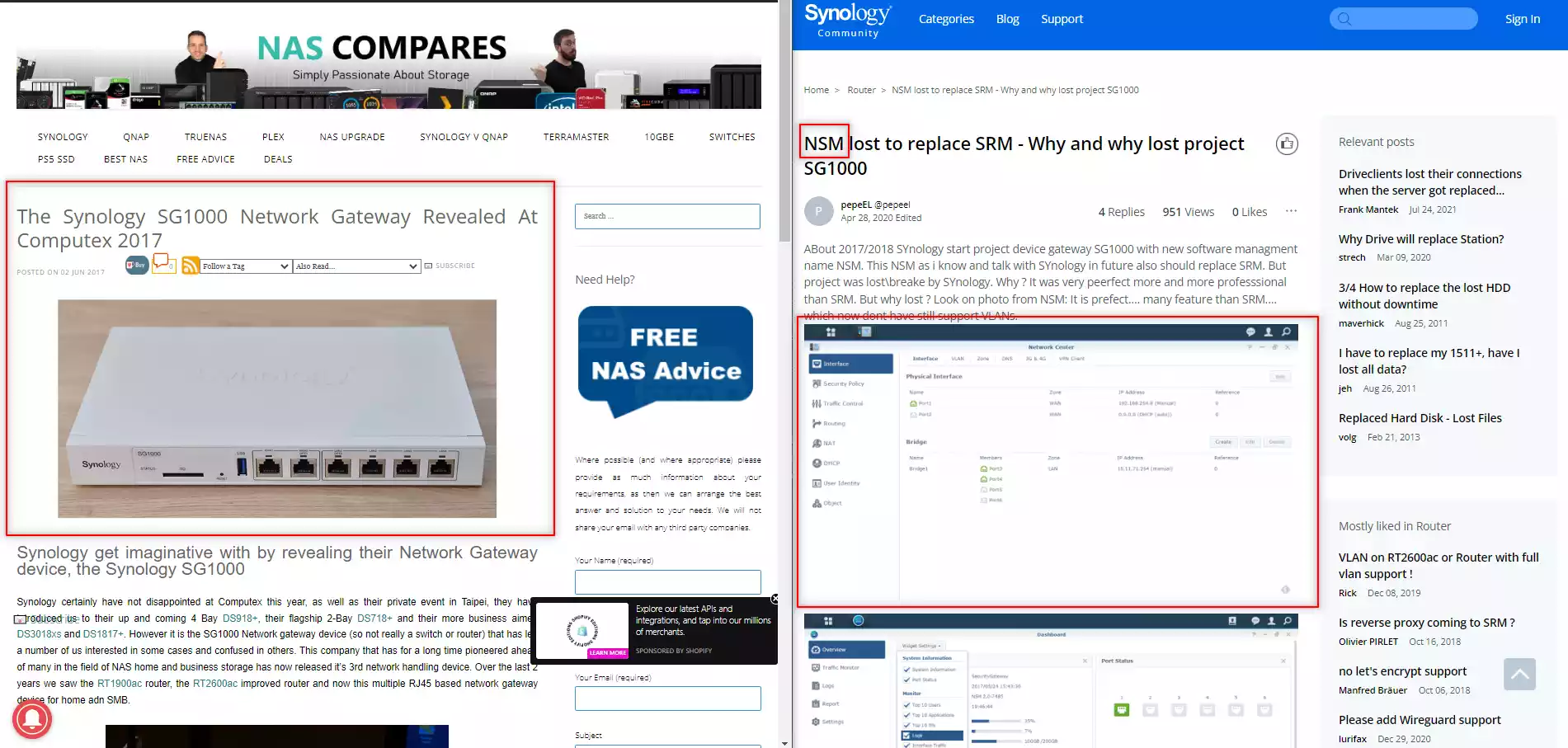
2022 saw several names in the world of NAS get successfully targetted by the ransomware group Deadbolt, yet Synology remained completely resilient and unaffected. What parts of Synology’s DSM design, architecture or company actions would you say were chiefly responsible for this impenetrability?
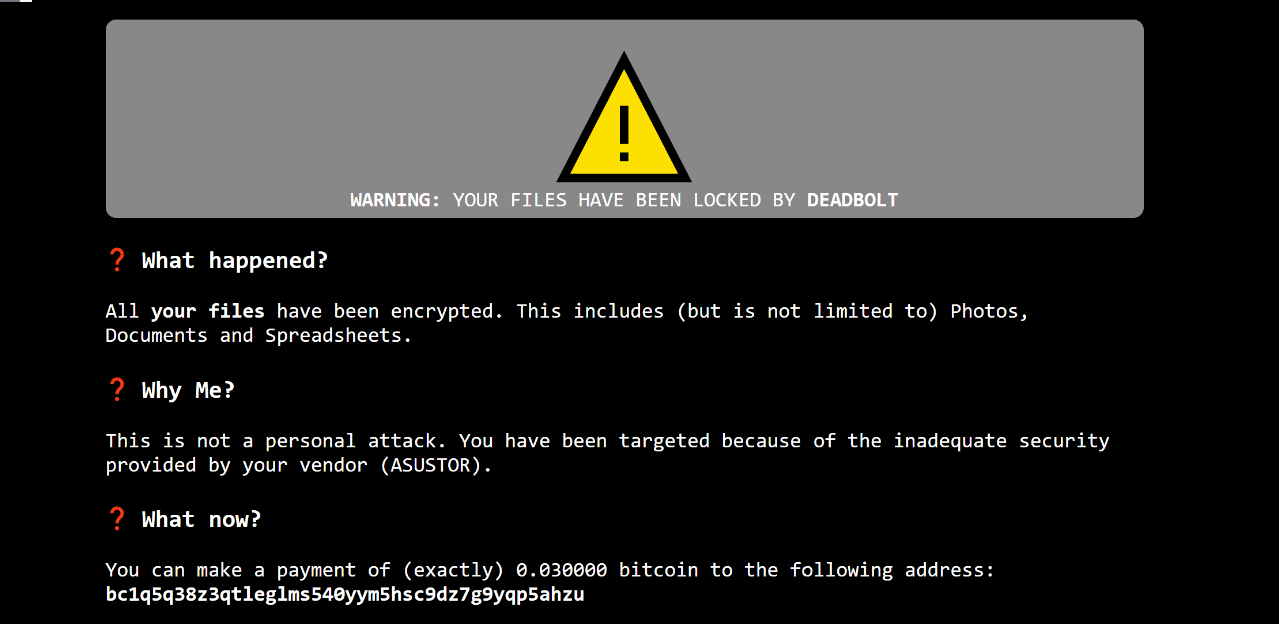
First of all, no system is free from security vulnerabilities. However, Synology devotes significant efforts to bolstering the security of our software and services, and we take a systematic approach to keeping up with known security issues. We’ve spent the past few years implementing company-wide reforms to focus on security and privacy, by design and by default. Finally, security is always about layers, which we have been steadily adding to. In DSM 7.0, we introduced a feature that allows us to globally ban malicious IPs. This is great for neutralizing threats from bot nets, for example. In DSM 7.2, we’re introducing a similar capability for our QuickConnect service. Both of these together allow rapid deployment of fleet-wide deny lists if we see an ongoing attack. Another core aspect that we’ve been working on is user account security. Many successful penetrations into a corporate network are done by “attacking the human.” Phishing, exploiting weak or reused passwords, and social engineering are all relatively simple approaches, but they’re still effective ways to gain access.
We’ve introduced Secure SignIn, which adds mobile login prompts and FIDO2/U2F integration for easier two-factor authentication (2FA). And even for accounts without 2FA, in DSM 7.2, we’re rolling out adaptive multifactor authentication in an effort to protect against breaches. There are many more features, development SOPs, and policies that all contribute to security of Synology systems and services. If there’s one additional thing I’d like to highlight, it would be our bounty program and our participation in hacking competitions, such as Pwn2Own. These programs together have contributed significantly by helping us identify security vulnerabilities and insight into how modern attacks are devised.
With the continued boom in Flash storage at the server level, do Synology plan on engaging with the U.2/NVMe Server market?
We’re always looking at adopting new and faster technologies, and implementing them in a way that makes sense for the majority of our target customers. And NVMe drives are definitely something we’ve been working with for a while, introduced all the way back on the DS918+. I think it’s safe to say that we’ll be looking at expanding our lineup in the future. With our expanding range of flash media already and our already well-established FlashStation series well positioned in the market, we are constantly reviewing the growing flash market and will continue to adapt our portfolio to meet customer needs and expectations.

Why do Synology NAS Systems currently only list HDD Compatibility up to 18 TB, despite 20 TB and 22 TB drives from the likes of WD and Seagate being available and tested in the field?
Each Synology system is thoroughly validated with a specific set of components. At the moment, our testing suite goes up to 18 TB, but it will be expanded in the future.
One criticism users had when the latest revisions of DSM were released concerned the subject of USB. Why were USB Peripheral Compatibility and Support in DSM 7 comparatively pared back compared with DSM 6.2?

USB peripheral compatibility was deprecated and later removed in DSM 7.0 because we didn’t see them in widespread use. While convenient for certain home and small business deployments, connecting USB devices to rackmount servers is not a common use case. Even on our tower systems (DiskStation), USB printers and Bluetooth/Zigbee-like adapters simply were not common enough to warrant continuous testing and integration of drivers. That said, we have seen community-developed drivers and solutions, for instance by using VMs and containers, so the possibility is still there, just not through DSM itself. We took the view that supporting USB peripheral compatibility for a decreasing user base, whilst ensuring security for all users was not warranted when that time and energy could go into further improving DSM’s features and functionality to the benefit of everyone using it.
The Synology BC500 and TC500 have seemingly filled a gap for Surveillance use in traditional ‘turnkey’ NAS that has been long ignored, allowing a single ecosystem Surveillance solution to be possible. However, there are only two models available. Will there be further releases in this product family in 2023?
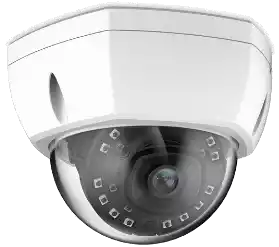
The BC500 and TC500 are just the first products in our camera lineup. Video surveillance has been a focus at Synology for a long time, so you can imagine we have a fairly comprehensive plan for expanding our video surveillance ecosystem. As with any newly developing arm in our portfolio, we want to ensure that are providing the best surveillance cameras for our user base and want to ensure that we can be as effective as possible in meeting their demand. Although numerous permutations of surveillance equipment were considered for our introduction to our own surveillance cameras (not limited to purely visual equipment), we wanted to start with the most requested and proven user-favoured options in our first wave, then build upon that with an expanded range. Initial response to these first two cameras has been exceptionally positive and development continues to move forward. For now, all we can say is stay tuned for more updates later this year.
Are there plans to introduce further optional upgrades in a similar form to the E10G22-T1-mini module? Such as an SFP alternative or 2.5G?
We’re actually fairly curious about the demand for an SFP+ version to the E10G22-T1-Mini. Our initial surveys told us RJ-45 would be the best interface for DiskStations, but we also know that many homelabs and such do run fiber connections. If a fiber-based upgrade for systems that support this module interface (eg, the DS923+ or RS422+) is something users are interested in, we would, of course, investigate further and develop further as needed. Would you be interested in running a survey to your audience?
Note – We conducted the poll mentioned above for 10 days on the homepage of NASCompares.com and it came pretty clear that, of those that voted, the option for a SFP+ or 2.5GBASE-T upgrade adapter was the most desired:
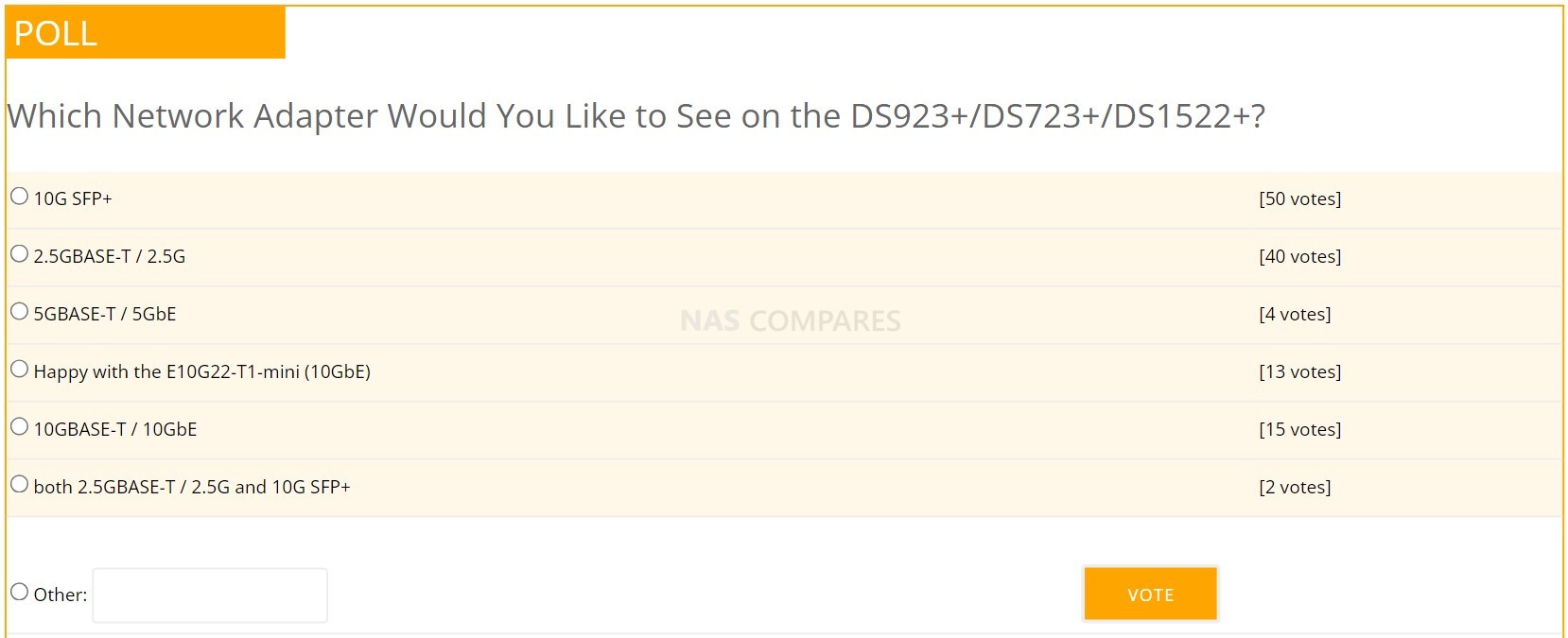
Does Synology have plans to expand the support of enhanced M.2 Storage Pool utilization towards more older generation devices that have this hardware feature?
When we recently introduced the use of storage pools for the M.2 slots of our 2022/2023 systems, we did so as the improvements in components (chiefly the CPUs we conclude are best for our systems that are constantly developed with) allowed us to take advantage of the improved bandwidth, whilst still maintaining system stability and access. This is going to be a continued feature for the foreseeable future and much like any other feature of our solutions, requires long-term support. We currently do not have plans to expand M.2 NVMe testing and validation to older/additional devices for the DSM 7.2 release cycle.
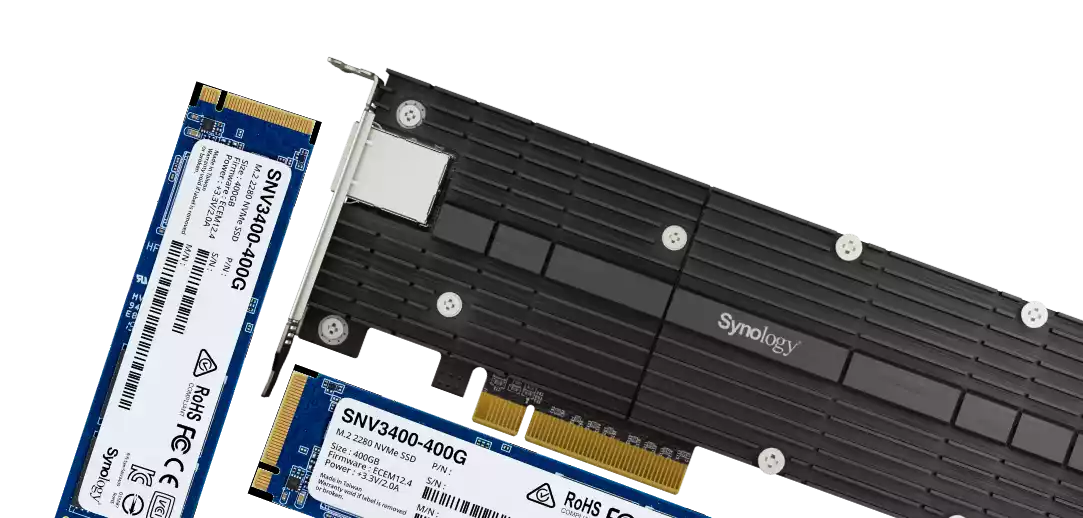
Are there any plans to provide M.2 NVMe Pool support to M.2 Upgrade Cards (such as M2D20 or E10GT20-T1)?
Much like your previous question regarding testing and validation of M.2 NVMe traditional storage pool user in older generation systems, we are choosing to prioritize these improved features on the hardware that is best placed in development to take advantage of it in DSM. This also extends to previously released accessories and addons, as these were not designed with this feature at launch, so we believe our users are best served when our development teams focus on the newer areas of our portfolio in this case to allow the best possible experience be achieved.
Are there any plans down the line to allow 3rd party SSDs for use as Pools (even in just mid-range Diskstation devices in the Plus series)?
M.2 NVMe SSD drives from third-party media brands have been supported for use in a large number of our systems for a long time, since their first introduction in our Synology DS918+. The introduction of m.2 bays in our desktop systems took a considerable amount of development, both in expected R&D and in verifying the available M.2 NVMe drives at the user’s disposal. Now this has become a widely supported feature in our range of solutions and the task of maintaining a verified compatibility list of supported drives has grown exponentially. With the newly introduced use of M.2 NVMe SSD storage pools, we are currently exploring how DSM can best take advantage of the improved storage potential in its system services, whilst still factoring in SSD lifespan and media temperatures as we have done with the use of our SAT5200/SAT5210 drives in our FlashStation series. With this in mind, are exploring this with our own SNV3400/SNV3410 storage media (as well as examining the need for improving this area of our portfolio further as we see how our users utilize this new feature of DSM 7.2), as further verifying 3rd party drives would take up considerable time and resources that we feel are better channelled towards improving the feature in DSM.

Are there any plans to reintroduce AI Subject Recognition into Synology Photos (as was, in Synology Moments)?
Yes, an early preview is actually available for demo at our event this week (referring to the Synology Showcase event in Taipei in late May ’23 – Learn more about that HERE). We are currently exploring a wide range of methods to better harness the use of AI in our DSM services, not just in our premier Photography application. We look forward to sharing how users can benefit from this later in 2023.
Are there any plans down the line to include WireGuard as a native application In the Package center? Or is this largely/exclusively down to WG going through the verification process?
VPNs are an important part of IT infrastructure and WireGuard is a very secure and fast protocol. However, the proper place to deploy a VPN server is generally not on your storage system, like a Synology NAS/SAN, but on your router or a dedicated VPN server. That said, you can still deploy WireGuard on Synology storage devices through containers. As always, we are closely monitoring our user demand and are happy to expand our range of 3rd party supported services in our application center if it’s warranted.
It’s great to see Full Volume Encryption in DSM 7.2, but some users are less keen on how the pass-key handling is implemented. Is there any plans to introduce an option to disable the internal key locker and keep the key purely offline (or perhaps USB based, or support non-Synology KMIP server providers) as well as a setting or the system not to auto-mount an encrypted volume at boot?
The short answer is yes, supporting 3rd-party KMIP servers is on our roadmap. The long answer is that, as with the introduction of all new features, volume encryption in DSM will continue to get new features and improvements as we collect feedback and usage metrics. Any new feature that we implement into DSM needs to spend a considerable amount of time in development in-house, being subjected to rigour testing. When it is then introduced to our user base in a beta form (either packed within a full system public beta or as a standalone beta for trial in our app center), this is done to access further improvements and changes that are implemented when it passes into a full release. However, the process does not stop there and when the user base for this feature continues to increase, greater improvements in its design and tooling that can only be made possible from extensive user feedback can be made. We maintain a long-term commitment to the features and services of DSM, and when we launched Full Volume Encryption (alongside DSM 7.2 immutable backup services) we wanted its introduction to provide a solid and robust foundation, which we can then grow upon to meet our user’s expectations.
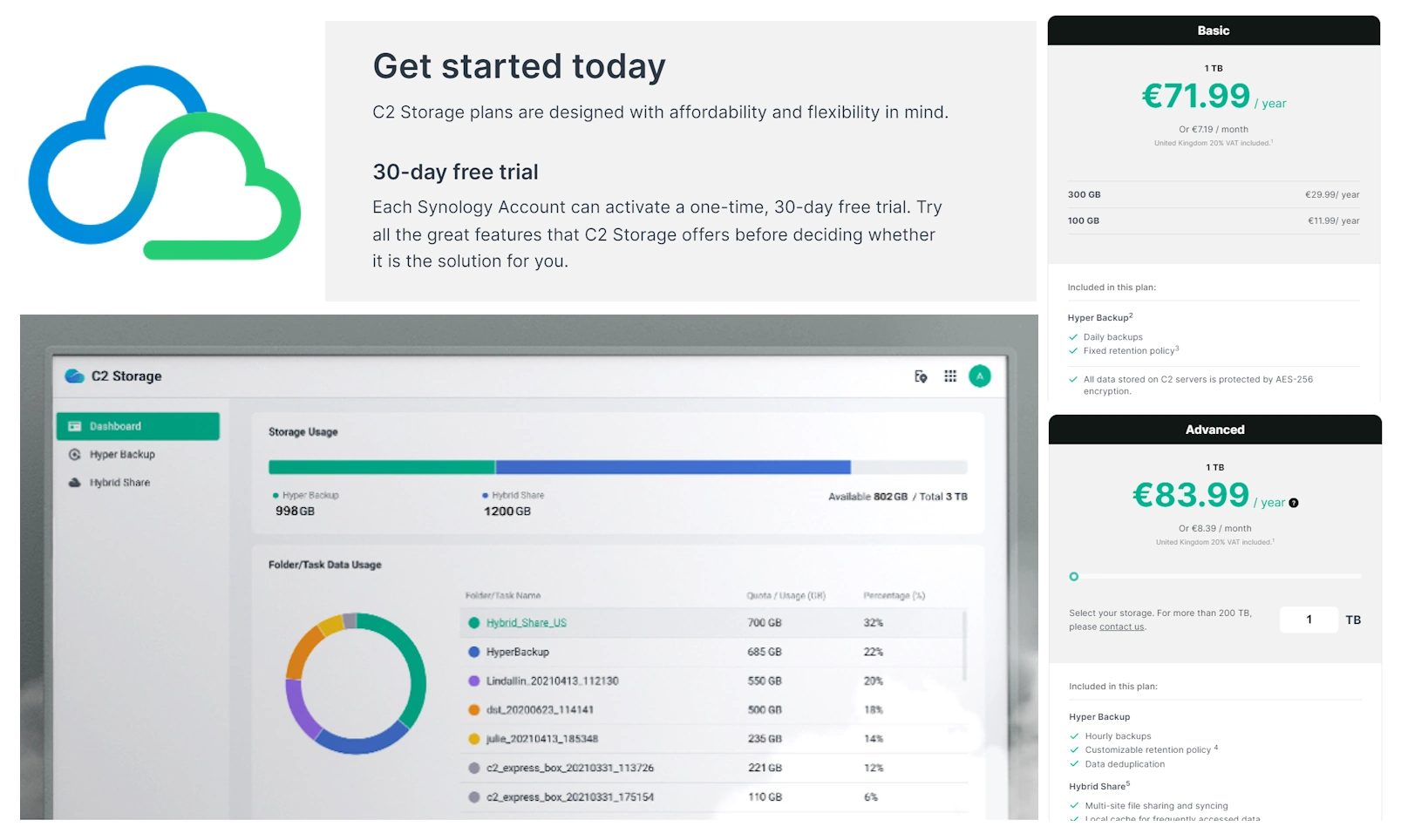
Given Synology’s unique position in providing both a bare metal/on-prem and subscription cloud service solution, would Synology ever consider providing Synology NAS users with an introductory inclusive area of Cloud storage on C2 with their purchase? (eg 25/50GB free space)?
We have seen very positive adoption of our C2 Cloud Storage service and as this area of our business grows, are scaling its scale and features constantly. We know that users who have introduced C2 into their on-prem Synology storage, do so because of its security, ease of use and scalability. Any decisions we make for C2 need to be closely examined and rigorously researched on behalf of the large number of users who trust us with their data. So providing an introductory area of storage to all Synology NAS users is a big decision that would need further investigation. At the moment, we believe C2 Storage is priced competitively as-is and that our customers generally already have a preferred provider or backup method. That said, we do offer 15 GB of free C2 Object Storage to any Synology Account user.
Any Plans for DSM 8 yet? 🙂
Of course 🙂
Thanks again to Michael Wang, Corporate Communications Manager Synology, for his time in answering these questions today. Looking forward to seeing what Synology 2024 has in store.
📧 SUBSCRIBE TO OUR NEWSLETTER 🔔 This description contains links to Amazon. These links will take you to some of the products mentioned in today's content. As an Amazon Associate, I earn from qualifying purchases. Visit the NASCompares Deal Finder to find the best place to buy this device in your region, based on Service, Support and Reputation - Just Search for your NAS Drive in the Box Below
🔒 Join Inner Circle
Get an alert every time something gets added to this specific article!
Need Advice on Data Storage from an Expert?
Finally, for free advice about your setup, just leave a message in the comments below here at NASCompares.com and we will get back to you.
 Need Help?
Where possible (and where appropriate) please provide as much information about your requirements, as then I can arrange the best answer and solution to your needs. Do not worry about your e-mail address being required, it will NOT be used in a mailing list and will NOT be used in any way other than to respond to your enquiry.
Need Help?
Where possible (and where appropriate) please provide as much information about your requirements, as then I can arrange the best answer and solution to your needs. Do not worry about your e-mail address being required, it will NOT be used in a mailing list and will NOT be used in any way other than to respond to your enquiry.
TRY CHAT
Terms and Conditions


ZimaOS is the BEST Beginner NAS OS - Watch Your Back UnRAID and TrueNAS !!!
30TB Hard Drives are TOO BIG ! (and here is why)
COMPLETE UGREEN NAS Setup Guide - 2025 EVERYTHING VERSION
$110 USB4 to 2x10Gb Adapter Review - What the WHAT?
UGREEN NAS Now has iSCSI, 2FA and Jellyfin (and more) - FINALLY!
Seagate 30TB Ironwolf and EXOS Hard Drive Review
Access content via Patreon or KO-FI


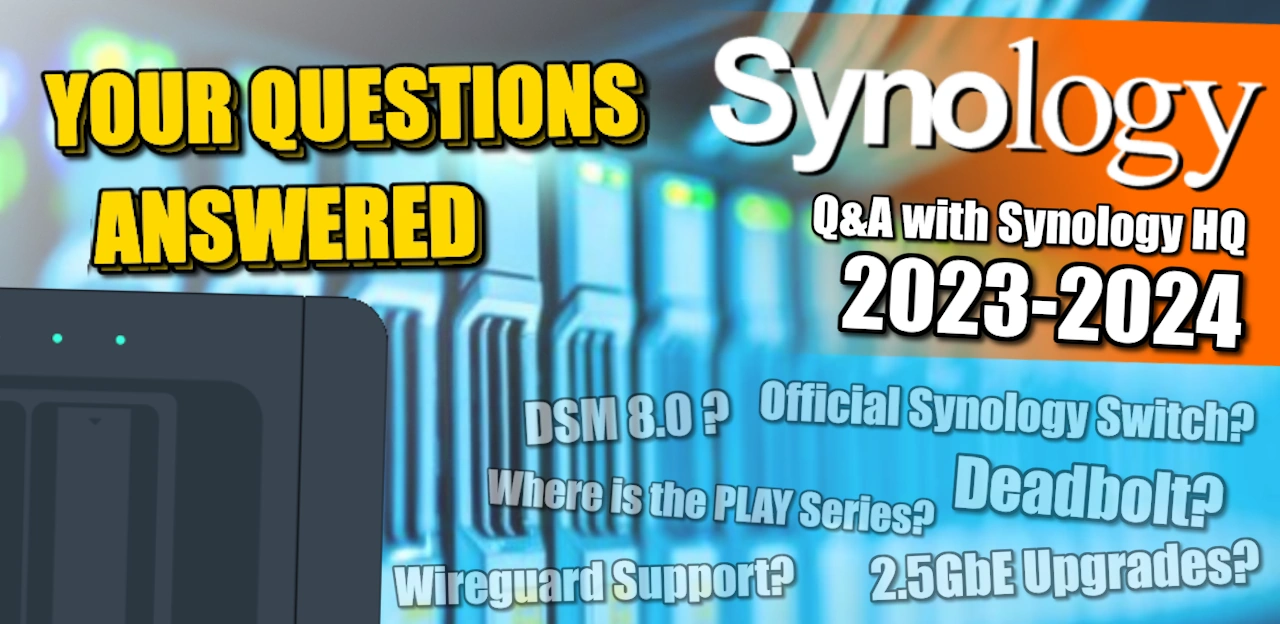



Does this work over the internet?
REPLY ON YOUTUBE
Any update with Synology AI?
REPLY ON YOUTUBE
I think on long term NVMe NAS systems will prevail since it will allow still affordable storage price and with a good processor…also very good solution to run multiple VM’s and containers at the faster speed rate.
I just can’t believe that SYNOLOGY is so behind after the NVMe development compared with the ASUSTOR, QNAP or even UGREEN ….
REPLY ON YOUTUBE
Latest rumours on DS1524+ ?
REPLY ON YOUTUBE
the reason Ive been building my own janky NAS is I want 10gb ethernet for my 6 SSDs. If Synology bring out a DS624slim with 10gb ethernet I will be first in line
REPLY ON YOUTUBE
Shonger lorther
REPLY ON YOUTUBE
RS1224P+???? ????
REPLY ON YOUTUBE
Still now 6/8 bay refreshes. SAD!
REPLY ON YOUTUBE
It’s February 2024. Still waiting for that 1624+ ????⏱????⏱????⏱????
REPLY ON YOUTUBE
do you think there will be a 724+?
REPLY ON YOUTUBE
do you think there will be a 724+?
REPLY ON YOUTUBE
no new models at all, right?
REPLY ON YOUTUBE
Any more news/rumours about a DS1824+ ???
REPLY ON YOUTUBE
Hey @NASCompares now that we are weeks away from 2024 do you have any updated thoughts on the 6-8bay lines refresh? any fresh rumours?
REPLY ON YOUTUBE
Be nice if they expand the HDD verified list and maybe finally give us 2.5Ghz network.
REPLY ON YOUTUBE
I’d just be happy getting a 2.5G nic on a plus series at this point. So I can use that one on my RT6600AX
REPLY ON YOUTUBE
DS1624+ please
REPLY ON YOUTUBE
How to integrate this optional ai?
REPLY ON YOUTUBE
Id like to see an affordable refresh of the VisualStation.
REPLY ON YOUTUBE
How about a successor to the MR2200AC, let’s say an MR2400AX? It seems silly having to buy a bunch of RT6600AXes or WRX560s, JUST to utilize Wi-Fi 6 in a mesh network, paying for that extra router & security capability when you don’t need it. Any news on expanding their WiFi 6-enabled mesh network?
REPLY ON YOUTUBE
Always wondered why there is no powerfull one bay nas.. with lots of memory and SSD extension.. Beats raid with a simpler usb3 connected identical backup drive..????
REPLY ON YOUTUBE
Do you think they might do a new a DVA model this year with the advancements in AI technology?
REPLY ON YOUTUBE
Why doesn’t Synology have a 2- or 4-bay Slim series (using SSDs)? Seems like the compact size and low noise would attract some SOHO buyers.
REPLY ON YOUTUBE
We’re in the era of data hoarders virtualization and Jellyfin/Plex. I’d argue for 6 to 8 bay consumer solutions with low power and lots of cores for virtualization for future proofing. AI, while the “hot topic”, isn’t today’s issue outside of limited uses (photos).
Hard to find satisfactory NAS in the market and certainly not Synology’s hardware 🙁
REPLY ON YOUTUBE
I can’t wait for more Synology products that are crippled out of the box by 1GbE ports.
REPLY ON YOUTUBE
Still running a ds2413+ and ds918+ … My 12 bay is being sweated to death
REPLY ON YOUTUBE
Any rumors of an upgrade of the RS1221RP+
Wanting to replace my aging, I still love it though, DS2415+ since it got cut out of the 7.2 upgrade. #sadnas
REPLY ON YOUTUBE
I’m just curious, I’m interested in purchasing a Synology for our production studio. Has anyone ever been hacked or is that common?
REPLY ON YOUTUBE
Dare I ask (in the unconfirmed section) if we suspect that the motherboards from the DS1824+ will be able to be retro fitted to a DS1821+. That is same chassis, new internals?
REPLY ON YOUTUBE
!WOOHOO! finally the DS1824+ a-coming;
Yous-gots-tos Save me the 1st one Robie 😉
REPLY ON YOUTUBE
Unless Synology has something like the ASUSTOR Flashstor, Synology and their tired, old spinning disks are irrelevant.
REPLY ON YOUTUBE
ed looks at things from a bussiness stand point and you think of what the user wants its a nice team you have
REPLY ON YOUTUBE
approaching 100k subs this is nice 🙂
REPLY ON YOUTUBE
i really like ed he such a nice guy
REPLY ON YOUTUBE
Yikes, it was like listening to a Synology apologist from your guest. Excited about Syno boxes? And 10GbE for the Plus series is “never going to happen; it will always be upgradable”?
First, I think we can make a stronger argument for being agast over excited, especially hardware wise.
Synology leans on its software, which is fair to a point, but its contemporaries across portfolio segments up and down the line have [had already] superior hardware — and openness. Networking, check. Processors and pre-installed memory, check. SSD storage without artificial fences, check.
NAS reviewers could take some cues from how GPUs are examined, including the impact the tech press can have. If Synology was putting out graphics cards against QNAP, for example, you’d be skewering the former. 1GbE would be akin to not offering AV1 encoding. And the proprietary 10GbE… Jebus… you should have the picture by now.
To address as well the statement about the Plus series and 10GbE: 1) The extreme cost of the XS+ series vis-a-vis the Plus boxes isn’t going to really create segment overlap (to say nothing of consumer drive support comparisons); and, 2) Again, the competition that lines up with Synology Plus products is either already there or will be there presently for standard equipment — or at least with non-closed upgrade paths at worst.
I’d say the sibling Asustor flash boxes that just arrived evidence the sea change that’s been happening on the garden variety consumer. There’s no excuse for spinning rust NASes to lag behind. In Synology’s case, it can’t claim for too long the R&D for DSM version X, Y or Z is being recovered to impact its margins and therefore what it can pack into their mid-range offrrings.
Synology absolutely has the ability to get with the times and mitigate the risks of being left behind if it won’t keep up. If it “will never” make changes, its monolith approach to the ever-evolving tech market/world will make it what Compuserve was the World Wide Web at large.
To be clear, I own three Syno boxes: an eight bay, four bay and a single bay machine. I’m not going to stick with the brand I’d it can’t — sorry, won’t — give me some sugar, Baby. 2.5GbE as standard on every box is a must. 10GbE on perhaps new eight bay Plus boxes would be progress, too, along with NVMe freedom. And if they really want to be kind, Synology can rewind and unblock USB device restrictions on those outdated type-A ports. 😉
REPLY ON YOUTUBE
Is there any chance the next big DSM release will get rid of the “unverified disk” nag screen warnings when you utilize HDDs that are not manufactured by Synology?? What a freaking JOKE.
REPLY ON YOUTUBE
When do you expect the release of DSM 8? After 6.2 there was 7.0
REPLY ON YOUTUBE
I want an M series Mac Mini working with my Synology Nas. Polishing the same turds.
REPLY ON YOUTUBE
The channel should be renamed SynologyCompares as lately seems most videos are Synology
REPLY ON YOUTUBE
i just want a hyper backup software that actually works for cloud backups.
3 – 10 MB/s max is ridiculous.
REPLY ON YOUTUBE
Pre watch: NO WHAMMY!! NO WAMMY!! Please have an 8 bay with UHD 770 expandable to petabytes.
Post watch: After watching the “confirmed” portion. Dang. Getting further away from practical Plex, jellyfin, emby server solutions.
REPLY ON YOUTUBE
Are you going to do the same for QNAP an Asustor? QNAP ha 5.1 release a weeks or 2 ago now. The Flashtor have really picked up a lot of interest. I might buy a 6 flash version and try it as a plex server.
REPLY ON YOUTUBE
The world has moved on. My tastes in media and performance expectations have changed. A newer processor and 2.5gbe nas struggles at times, Synology isn’t relevant for most people I know. I love the software and having an email server, but there is no way is it worth it. Again, most users will be lucky to be in the OS once a month, they want performance in the job it’s doing.
REPLY ON YOUTUBE
Please create YouTube shorts for this and other videos…will help get footfall to channel….40 min video good for hardcore NAS people and shorts will be good for enthusiasts/beginners
REPLY ON YOUTUBE
DS124 is such a weird product line. It is a DS223J with only 1 bay, and priced almost similar.
Since both have the identical spec, CPU and Ram, I went with DS223J that gets me an additional bay.
I think DS124 should be price much lower. If there ever a DS123J, the only difference between the 2 is color. So weird.
REPLY ON YOUTUBE
Faster nics?
REPLY ON YOUTUBE
AV1 support? ????
REPLY ON YOUTUBE
Here is a guestion that never seems to be asked…
Synology HDD compatibility list testing is TERRIBLE at best. They only test the very latest available HDD models for their new releases. The grandfather nothing into the list even though everyone knows they work. For example, if a drive worked on the DS920+, it will work on the DS423+. Basically the SAME HARDWARE.
If they did not provide the absurd messages when you create a storage pool, it wouldn’t matter. Unfortunately, they pop up very misleading messages, giving the impression that if they have not tested the HDD, then it is not safe for the data. Of course, this is absurd.
The question is. If this is not strictly a money grab to push very overpriced Synology Branded Toshiba and Seagate Drives, then what is the reason to pop up misleading messages as a result of incomplete and inadequate testing at Synology.
My suggestion. Remove the pop ups or invest in the COMPLETE testing process. Anything else just devalues the Synology Brand as not being compatible with mainstream major branded NAS HDD manufacturers.
I wonder what AI used in this way will mean for communication. I mean, what’s the point if you receive an informal e-mail from a friend that was written by a computer?
REPLY ON YOUTUBE
AI is going crazy! Wonder when it will be integrated into finance to pick stocks or betting at the horse races?! ????
REPLY ON YOUTUBE
They really need to work on the Photos app
REPLY ON YOUTUBE
No thanks.
REPLY ON YOUTUBE
It would be great if there was something like an AI firewall, AI antivirus and other security applications where AI would identify an attack and be able to take actions to defend the system and data, without user involvement and 24/7.
REPLY ON YOUTUBE
No seagulls….???????????????? ????????????
REPLY ON YOUTUBE
I like this as part of Synology Office and mail. That’s where I see AI being the most useful today. Now all they need is a neuromorphic chip or built in accelerator to push this AI to the edge and have it built into the NAS. Kind of like our spell checkers. You have one locally on your pc that works w/o a network connection in a word processor, then for a larger library it can connect to a server if a network connection is available. If “AI” doesn’t blow out like “Blockchain” and crash like Crypto (All FADS do). Then in 10 years we will see it built into our office devices. I wonder what sort of NEW security concerns this will bring about? I can see it being banned or highly restricted in government use.
REPLY ON YOUTUBE
First
REPLY ON YOUTUBE